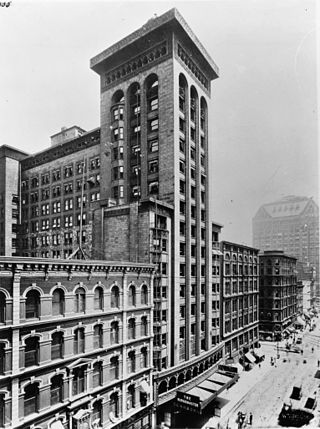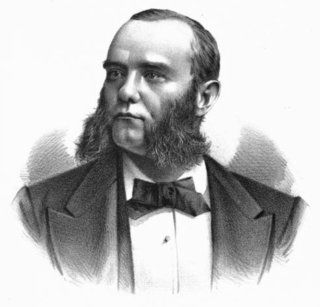
Lorenzo Brentano was a German revolutionary and journalist who served as President of the Free State of Baden during the 1849 Baden Revolution. Following the failure of the revolutions, he and many other intellectuals and leaders fled to the United States, where he became editor of the Illinois Staats-Zeitung and eventually served as a member of the United States House of Representatives from Illinois.

The New Yorker Staats-Zeitung, nicknamed "The Staats", claims to be the leading German-language weekly newspaper in the United States and is one of the oldest, having been published since the mid-1830s. In the late 19th century, it was one of New York City's major daily newspapers, exceeded in circulation only by the New York World and the New-York Tribune. Among other achievements, as of its sesquicentennial anniversary in 1984 it had never missed a publication date, thereby laying claim to the title of being continuously published longer than any other newspaper in America.
Der Baltimore Wecker was a daily paper published in the German language in Baltimore, Maryland. It was the object of violence in the civil unrest at Baltimore in April 1861 that produced the first bloodshed of the American Civil War.

George Schneider (1823–1905) was a German American journalist and banker who served as editor-in-chief of the Illinois Staats-Zeitung. He was appointed by President Abraham Lincoln as the United States Consul in Elsinore, Denmark, at the outbreak of the American Civil War and later served as Collector of Internal Revenue for the 1st District of Illinois. He was a German refugee, one of the Forty-Eighters.

The Schiller Theater Building was designed by Louis Sullivan and Dankmar Adler of the firm Adler & Sullivan for the German Opera Company. At the time of its construction, it was among the tallest buildings in Chicago. Its centerpiece was a 1300-seat theater, which is considered by architectural historians to be one of the greatest collaborations between Adler and Sullivan.

Hermann Raster was an American editor, abolitionist, writer, and anti-temperance political boss who served as chief editor and part-owner of the Illinois Staats-Zeitung, a widely circulated newspaper in the German language in the United States, between 1867 and 1891. Together with publisher A.C. Hesing, Raster exerted considerable control over the German vote in the Midwest and forced the Republican Party to formally adopt an anti-prohibition platform in 1872, known as the Raster Resolution. He was appointed as Collector of Internal Revenue for the First District of Illinois by President Ulysses S. Grant but resigned from this post shortly thereafter. Raster returned to Europe in 1890 when his health began to fail him and died filling a minor diplomatic role in Berlin. Today he is best remembered for his extensive correspondence with Western intellectual and political figures of the time, such as Joseph Pulitzer, Elihu Washburne, and Francis Wayland Parker, much of which is preserved at the Newberry Library in Chicago.

Wilhelm Georg Rapp (1827–1907) was a Jewish German American journalist, abolitionist, and newspaper editor. He was born in Lindau, Bavaria, but grew up in Baden. As a student at University of Tübingen Rapp participated in the German revolution of 1848, and was imprisoned for a year for his activities. Upon his release Rapp lived in Switzerland, where he taught school before emigrating to the United States in 1852.

Paul Grottkau (1846–1898) was a German-American socialist political activist and newspaper publisher. Grottkau is best remembered as an editor alongside Haymarket affair victim August Spies of the Chicagoer Arbeiter-Zeitung, one of the leading American radical newspapers of the decade of the 1880s. Later moving to Milwaukee, Grottkau became one of the leading luminaries of the socialist movement in Wisconsin.

Historically, Chicago has had an ethnic German population. As of the 2000 U.S. Census, 15.8% of people in the Chicago area had German ancestry, and those of German ancestry were the largest ethnic group in 80% of Chicago's suburbs. As of the year 1930, those of German ancestry were the largest European ethnic group in Chicago. However, as of today that number has decreased to 6%.

"Reisebriefe von Hermann Raster: mit einer Biographie und einem Bildniss des Verfassers" is a biography and collection of travel essays by German-American editor and politician Hermann Raster. It was published posthumously in 1891. The novel was accredited to its subject and the author of the essays, Hermann Raster, though the introduction and biographer remain unknown. The essays chronicle the life travels and experiences of Raster, who was a Forty-Eighter best known for being Editor-in-Chief of the Illinois Staats-Zeitung and Collector of Internal Revenue for the First Illinois District. He was a correspondent for several German newspapers in America and an ardent abolitionist before and during the American Civil War.

Anton Caspar Hesing (1823–1895), known as "Boss Hesing", was a German-American newspaper publisher and political boss who became a prominent figure in Chicago during the second half of the 19th Century. The long-time publisher of the Illinois Staats-Zeitung and political boss of the pro-liquor wing of the Republican Party, Hesing is remembered as one of the most influential figures of the 1870s in the emerging metropolis of Chicago, responsible, alongside his compatriot Hermann Raster, for the adoption of a national anti-temperance platform for the Republican Party in 1872, the creation of the People's Party in 1873, and the subsequent election of Harvey Doolittle Colvin as Mayor of Chicago. During his final years, the wealthy Hesing engaged in a number of philanthropic ventures, including a large role in financing of Chicago's Schiller Theater.
German American journalism includes newspapers, magazines, and the newer media, with coverage of the reporters, editors, commentators, producers and other key personnel. The German Americans were thoroughly assimilated by the 1920s, and German language publications one by one closed down for lack of readers.

Washington Hesing (1849-1897) was an American newspaper editor and political figure primarily known for his ownership of the Illinois Staats-Zeitung and his term as postmaster of Chicago during the second term of President Grover Cleveland.
The People's Party was a short-lived political party in the state of Illinois, founded in 1873 in the interest of combating the temperance movement and alcohol prohibition in Chicago.

Joseph Brucker was an Austrian American newspaper editor who was active in the Republican Party, serving as Secretary of the Wisconsin Republican State Convention and as a member of the Illinois Republican State Central committee.

In the Chicago mayoral election of 1893, Democrat Carter Harrison Sr. won election, returning him the mayor's office for a (then-record) fifth non-consecutive term as mayor of Chicago. Harrison won a majority of the vote, defeating the Republican nominee, businessman Samuel W. Allerton, by a ten point margin. He also defeated two third-party candidates: United Citizens nominee DeWitt Clinton Cregier and Socialist Labor Party nominee Henry Ehrenpreis, neither of whom received strong support.

In the Chicago mayoral election of 1869, Citizens Party nominee Roswell B. Mason defeated Republican nominee George W. Gage by a landslide 27-point margin.

In the Chicago mayoral election of 1897, Democratic nominee Carter Harrison Jr. was elected, winning a majority of the vote and defeating independent Republican John Maynard Harlan, Republican nominee Nathaniel C. Sears, independent Democrat Washington Hesing, as well as several minor candidates. Harrison carried a 26.7 point lead over second-place finisher Harlan, a margin greater than Harlan's vote share itself.
The New-Yorker Abend-Zeitung was a daily evening German language newspaper in New York City published from 1851 to 1874 that directly competed with the Democratic New Yorker Staats-Zeitung.

























